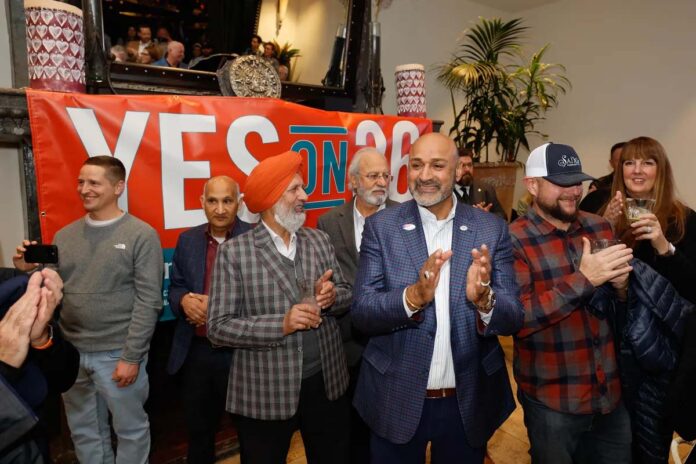Supporters of Prop. 36 say it would help the state address homelessness, drug addiction and retail theft. Its critics call it a return to the failed policies of the war on drugs
by Nigel Duara
CalMatters
California voters overwhelmingly passed Proposition 36 on Tuesday, capping a chaotic 10 months of bargaining and wrangling at the state Capitol where Democratic leaders unsuccessfully sought to preserve a decade of criminal justice reform.
Instead, the campaign to increase penalties for theft and repeated convictions for drug possession looks to have won out.
Prop. 36, opposed by Gov. Gavin Newsom, reclassiffies some misdemeanor theft and drug crimes as felonies.
The measure also creates a new category of crime — a “treatment-mandated felony.” People who don’t contest criminal charges after multiple drug possession convictions could complete drug treatment instead of going to prison, but if they don’t finish treatment, they still face up to three years in prison.
Property crime spiked in California after the pandemic while the state, counties and local governments have struggled to contain and control sidewalk encampments of homeless people.
Prop. 36 was pitched by supporters as a solution to those problems Led by the retail industry, they pledged that the measure would target drug traffickers and people who commit multiple acts of retail theft.
They raised about $17 million for the measure, which in addition to big checks from major retailers also included contributions from the California District Attorneys Association and the California Correctional Peace Officers Association.
Opponents raised about $7.7 million, which included contributions from the ACLU, teachers unions and the labor organization Service Employees International Union.
Prop. 36 reverses some of the changes California voters made to the criminal justice system a decade ago with Proposition 47, which lowered the penalties for some crimes while seeking to reduce the state’s then-swollen prison population.
Polls leading up the election consistently showed a large majority of likely voters supported Prop. 36. Several Democratic big city mayors and district attorneys threw their support behind it, too, despite Newsom’s opposition.
“Tonight, California voters have spoken with a clear voice on the triple epidemics of retail theft, homelessness and fatal drug overdoses plaguing our state,” San Jose Mayor Matt Mahan said in a written statement. “In supporting Proposition 36, they said yes to treatment. They said yes to accountability. And they said yes to putting common sense before partisanship, so we can stop the suffering in our communities.
What led to Prop. 36?
Since California voters passed Prop. 47 in 2014, prosecutors, police and big box retailers have blamed the law for an increase in property crimes and homelessness. Prop. 36 is their attempt to unwind some elements of the previous initiative.
During the pandemic, the rate of shoplifting and commercial burglaries skyrocketed, especially in Los Angeles, Alameda, San Mateo and Sacramento counties. Statewide, the Public Policy Institute of California found that reported shoplifting of merchandise worth up to $950 soared 28 percent over the past five years. That’s the highest observed level since 2000.
Combining shoplifting with commercial burglaries, the institute’s researchers found that total reported thefts were 18 percent higher than in 2019.
Another facet of pandemic-era shoplifting were viral videos of mobs of people rushing into stores and grabbing whatever they could before fleeing. Prop. 36 allows felony sentences for theft to be extended by three years if three or more people commit the crime together.
What will California crime measure cost?
The Legislative Analyst’s Office forecasts that the measure will cost tens of millions to hundreds of millions of dollars annually.
Those costs are chiefly from placing a few thousand more people in prison and putting them in for longer terms. The rest of the costs to the state will be accrued in the court system, where felonies take longer to prosecute than misdemeanors, and where the county court systems will have to create new processes to handle the measure’s new category of crime, a treatment-mandated felony.
Some of those costs will also be borne by the county court systems themselves, which the Legislative Analyst’s Office predicts will amount to tens of millions each year.
Who supported Prop. 36?
Supporters pitched Prop. 36 as a way to combat homelessness, which is up by more than 50 percent since Prop. 47 passed. The reason, supporters say, is that drug dependence pushes people to the street, and increasing the penalties for drug possession is the only way to force people into treatment.
Supporters also say Prop. 36 is a good middle ground between California’s tough-on-crime days, which pushed prison capacity past its breaking point, and the last decade under Prop. 47, which they say created “loopholes in state law that criminals exploit to avoid accountability for fentanyl trafficking and repeat retail theft.”
Who opposed Prop. 36?
Opponents, including the governor and Democratic leadership, say that no studies on criminal justice or homelessness support the idea that harsher punishment — or the threat of harsher punishment — prevents crime or gets people off the street.
The measure’s opponents include the American Civil Liberties Union of Northern California, the Alliance for Safety and Justice and the California Democratic Party.
The measure’s opponents argued Prop. 36 marks a return to the war on drugs, which they said California voters rejected a decade ago with Prop. 47.
Newsom did not put any money into opposing the measure, but he has called attention to its potential to drive up spending on the justice system.
“It’s the prevailing wind, and I understand it. I just hope people take the time to understand what they’re supporting,” Newsom said in remarks to reporters last week. “It’s just drug policy reform. It’s unfunded and unfortunately, it may impact some existing drug treatment and mental health services.”



